Unit one 教学设计
初中英语译林版unit1教案

初中英语译林版Unit 1教案教学目标:1. 掌握基本的英语词汇和表达方式。
2. 培养学生的英语听说读写能力。
3. 引导学生了解英语国家的文化和生活方式。
教学内容:1. 词汇:掌握本单元的生词和短语。
2. 对话:学习基本对话,提高学生的口语表达能力。
3. 阅读:阅读一篇与单元主题相关的文章,培养学生的阅读理解能力。
4. 语法:学习本单元的语法知识点,包括现在进行时和比较级。
教学步骤:1. 导入(5分钟)通过歌曲、游戏或其他活动导入本单元的主题,激发学生的学习兴趣。
2. 词汇学习(15分钟)教授本单元的生词和短语,包括发音、词性、用法等。
采用多种教学方法,如图片、实物、游戏等,帮助学生记忆和理解。
3. 对话学习(15分钟)学习基本对话,包括问候、介绍、询问等日常用语。
通过角色扮演、小组讨论等方式,让学生在实际情境中运用所学对话。
4. 阅读理解(15分钟)阅读一篇与单元主题相关的文章,引导学生理解文章大意,回答相关问题。
培养学生的阅读理解能力和阅读速度。
5. 语法讲解(15分钟)讲解本单元的语法知识点,包括现在进行时和比较级。
通过例句和练习题,帮助学生理解和掌握语法规则。
6. 练习与巩固(10分钟)通过练习题、听力、口语等方式,巩固所学词汇、对话和语法知识。
及时纠正学生的错误,提高学生的学习效果。
7. 课堂小结(5分钟)对本节课所学内容进行总结,强调重点和难点。
布置课后作业,要求学生复习所学内容,预习下一单元内容。
教学评价:1. 通过课堂表现、作业完成情况、考试成绩等方式评价学生的学习效果。
2. 及时反馈学生的学习情况,鼓励学生积极参与课堂活动,提高学习自信心。
高一英语必修一unit1教案
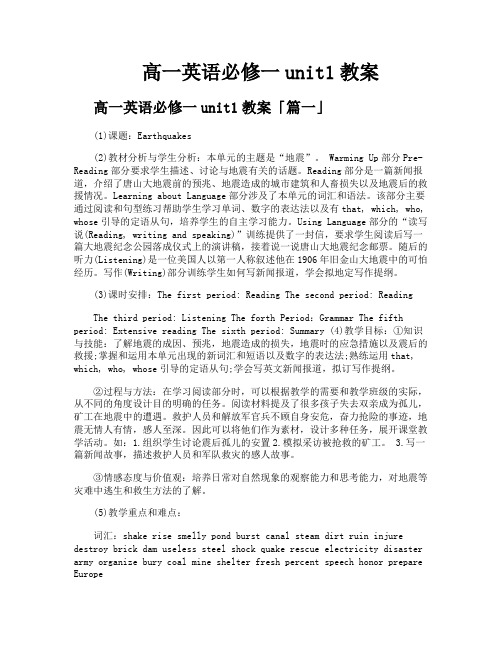
高一英语必修一unit1教案高一英语必修一unit1教案「篇一」(1)课题:Earthquakes(2)教材分析与学生分析:本单元的主题是“地震”。
Warming Up部分Pre-Reading部分要求学生描述、讨论与地震有关的话题。
Reading部分是一篇新闻报道,介绍了唐山大地震前的预兆、地震造成的城市建筑和人畜损失以及地震后的救援情况。
Learning about Language部分涉及了本单元的词汇和语法。
该部分主要通过阅读和句型练习帮助学生学习单词、数字的表达法以及有that, which, who, whose引导的定语从句,培养学生的自主学习能力。
Using Language部分的“读写说(Reading, writing and speaking)”训练提供了一封信,要求学生阅读后写一篇大地震纪念公园落成仪式上的演讲稿,接着说一说唐山大地震纪念邮票。
随后的听力(Listening)是一位美国人以第一人称叙述他在1906年旧金山大地震中的可怕经历。
写作(Writing)部分训练学生如何写新闻报道,学会拟地定写作提纲。
(3)课时安排:The first period: Reading The second period: ReadingThe third period: Listening The forth Period:Grammar The fifth period: Extensive reading The sixth period: Summary (4)教学目标:①知识与技能:了解地震的成因、预兆,地震造成的损失,地震时的应急措施以及震后的救援;掌握和运用本单元出现的新词汇和短语以及数字的表达法;熟练运用that, which, who, whose引导的定语从句;学会写英文新闻报道,拟订写作提纲。
②过程与方法:在学习阅读部分时,可以根据教学的需要和教学班级的实际,从不同的角度设计目的明确的任务。
Unit1教案:课堂互动教学方案

Unit1教案:课堂互动教学方案教学目标1.掌握英语单词的发音和拼写。
2.学习英国的传统文化,如食物、节日和运动。
3.培养学生的口语、听力和阅读能力。
4.鼓励学生积极参与课堂互动。
教学过程Step1:引入老师向学生介绍本次课的主题:英国文化。
然后给学生看一些图片,帮助他们预习本次课要学习的内容。
让学生根据看到的图片讲述英国的传统文化,如约克郡布丁、莱斯特市面包、万圣节等。
Step2:掌握单词老师让学生先看一遍单词表,然后在黑板上展示每个单词,并发音和拼写。
让学生跟读,并在课本上写下这些单词。
Step3:听力练习放一段英国古董路线的录音。
让学生听一遍后,用单词表格填空。
然后再听一遍录音,让学生检查自己的答案。
Step4:阅读练习老师给学生分发关于英国文化的材料,让他们自己阅读并回答问题。
然后老师点名让学生逐个回答问题。
Step5:语音练习老师教学生们正确的语音和发音。
让每个学生读出单词,然后老师纠正他们的发音。
让学生互相练习并改正他们的发音。
Step6:课堂互动分组让学生互相交流,分享他们在英国文化上学习到的东西。
鼓励学生使用他们学到的单词和语言技能,积极参与互动。
Step7:练习老师发放练习册,让学生做题。
这些问题涉及到听力、阅读、语法和单词拼写,帮助学生巩固他们的英语技能。
Step8:评价老师对本课程进行总结。
检查学生是否已经掌握了本单元的目标,并给予他们反馈和建议。
教学效果通过这一教学方案的实施,学生们将获得以下效果:1.在掌握英语单词的发音和拼写方面,取得了重大进展。
2.学习和了解了英国的传统文化。
3.培养了学生的口语、听力和阅读能力。
4.通过课堂互动,鼓励学生积极参与,并提高了他们的英语技巧。
5.获得了更多的自信和积极性。
结论本课程的课堂互动教学方案是非常成功的。
它允许学生充分发挥他们的学习能力,并鼓励他们积极参与课堂。
此外,它还开发和扩展了学生的语言技能,并帮助他们更好地掌握了英语的学习。
六年级上册英语教案UnitOneLesson1北京版
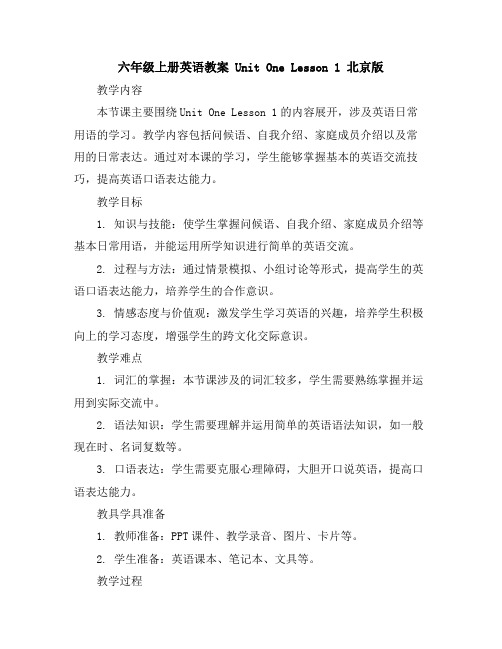
六年级上册英语教案 Unit One Lesson 1 北京版教学内容本节课主要围绕Unit One Lesson 1的内容展开,涉及英语日常用语的学习。
教学内容包括问候语、自我介绍、家庭成员介绍以及常用的日常表达。
通过对本课的学习,学生能够掌握基本的英语交流技巧,提高英语口语表达能力。
教学目标1. 知识与技能:使学生掌握问候语、自我介绍、家庭成员介绍等基本日常用语,并能运用所学知识进行简单的英语交流。
2. 过程与方法:通过情景模拟、小组讨论等形式,提高学生的英语口语表达能力,培养学生的合作意识。
3. 情感态度与价值观:激发学生学习英语的兴趣,培养学生积极向上的学习态度,增强学生的跨文化交际意识。
教学难点1. 词汇的掌握:本节课涉及的词汇较多,学生需要熟练掌握并运用到实际交流中。
2. 语法知识:学生需要理解并运用简单的英语语法知识,如一般现在时、名词复数等。
3. 口语表达:学生需要克服心理障碍,大胆开口说英语,提高口语表达能力。
教具学具准备1. 教师准备:PPT课件、教学录音、图片、卡片等。
2. 学生准备:英语课本、笔记本、文具等。
教学过程1. 导入:通过播放英语歌曲或短片,激发学生学习英语的兴趣,为新课的学习做好铺垫。
2. 新课内容学习:教师讲解问候语、自我介绍、家庭成员介绍等基本日常用语,并通过PPT展示相关图片,帮助学生理解和记忆。
3. 情景模拟:学生分组进行角色扮演,模拟真实场景,运用所学知识进行英语交流。
4. 小组讨论:学生分组讨论所学内容,巩固知识,提高口语表达能力。
6. 作业布置:布置课后作业,巩固所学知识。
板书设计Unit One Lesson 1重点词汇:如“hello”、“goode”、“my name is”等。
重点句子:如“How are you?”、“I'm fine, thank you.”等。
语法知识:如一般现在时、名词复数等。
作业设计1. 书面作业:要求学生完成课后练习题,巩固所学知识。
人教版unitone教案
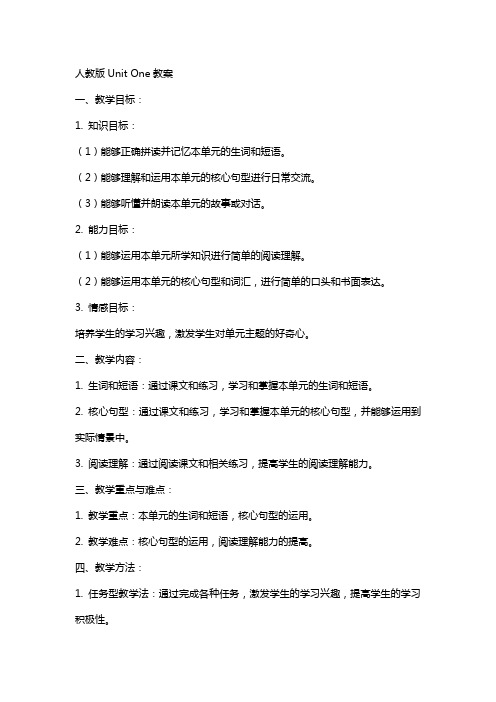
人教版Unit One教案一、教学目标:1. 知识目标:(1)能够正确拼读并记忆本单元的生词和短语。
(2)能够理解和运用本单元的核心句型进行日常交流。
(3)能够听懂并朗读本单元的故事或对话。
2. 能力目标:(1)能够运用本单元所学知识进行简单的阅读理解。
(2)能够运用本单元的核心句型和词汇,进行简单的口头和书面表达。
3. 情感目标:培养学生的学习兴趣,激发学生对单元主题的好奇心。
二、教学内容:1. 生词和短语:通过课文和练习,学习和掌握本单元的生词和短语。
2. 核心句型:通过课文和练习,学习和掌握本单元的核心句型,并能够运用到实际情景中。
3. 阅读理解:通过阅读课文和相关练习,提高学生的阅读理解能力。
三、教学重点与难点:1. 教学重点:本单元的生词和短语,核心句型的运用。
2. 教学难点:核心句型的运用,阅读理解能力的提高。
四、教学方法:1. 任务型教学法:通过完成各种任务,激发学生的学习兴趣,提高学生的学习积极性。
2. 情境教学法:通过创设各种情境,让学生在实际情境中学习和运用所学知识。
3. 交际法:通过小组讨论和角色扮演等交际活动,提高学生的口头表达能力。
五、教学步骤:1. 热身活动:通过歌曲、游戏等方式,激发学生的学习兴趣,导入本单元主题。
2. 生词和短语学习:通过课文和练习,学习和掌握本单元的生词和短语。
3. 核心句型学习:通过课文和练习,学习和掌握本单元的核心句型,并能够运用到实际情景中。
4. 阅读理解:通过阅读课文和相关练习,提高学生的阅读理解能力。
5. 巩固活动:通过小组讨论、角色扮演等方式,巩固所学知识,提高学生的口头表达能力。
六、教学评估:1. 课堂参与度:观察学生在课堂活动中的参与情况,包括发言、讨论、角色扮演等。
2. 生词和短语掌握:通过默写、填空、抽问等方式检查学生对生词和短语的掌握情况。
3. 核心句型运用:通过情景模拟、小组讨论等方式检查学生对核心句型的运用情况。
4. 阅读理解:通过阅读测试题或小组讨论检查学生的阅读理解能力。
(PEP)小学三年级英语上册《Unit 1 Making friends》大单元整体教学设计

新人教版(PEP)小学三年级英语上册《Unit 1 Making friends》——大单元整体教学设计一、内容分析与整合(一)教学内容分析《Making Friends》作为人教版英语三年级上册的起始单元,其重要性不言而喻。
这一单元不仅承载着引导学生踏入英语学习新阶段的使命,更肩负着培养他们基本社交技能的重任,尤其是如何与人建立和维护友谊这一核心议题。
在Part A部分,“How do we greet friends?”通过生动有趣的课堂活动,学生们将被带入一个充满互动的学习环境。
他们将学习如何用简单的英语问候语来开启一段对话,如“Hello, I'm ...”和“Nice to meet you.”,这些基本的交际用语将成为他们英语社交的敲门砖。
结合身体部位词汇的学习,如ear, hand, eye, mouth, arm等,学生们将在实践中掌握与这些词汇相关的动作指令,使英语学习与实际生活紧密相连。
Phonics教学的引入,让学生们在轻松愉快的氛围中掌握字母A a-D d的发音,为日后的词汇学习和阅读打下坚实的基础。
进入Part B,“How can we be a good friend?”则更深层次地探讨了友谊的真谛。
通过一系列角色扮演和情境模拟,学生们将学会如何通过具体的行动,如微笑(smile)、倾听(listen)、帮助(help)、分享(share)等,来表达友好和建立深厚的友情。
阅读材料《I am a good friend!》以其温馨的故事情节,帮助学生深刻理解友谊的重要性,激发他们成为更好朋友的愿望。
Part C作为可选内容,鼓励学生发挥创意,制作一张关于“如何交朋友”的思维导图。
这一活动不仅促进了学生对本单元知识的系统回顾和总结,还极大地提升了他们的综合运用能力和创新思维。
而扩展阅读材料“My new friend Zoom”则是对友谊主题的进一步延伸。
学生们将通过这篇简单现在时叙述的文章,学习到如何用英语描述自己的新朋友和与之相关的经历,从而在语言实践中加深对友谊价值的理解和感受。
(高一英语教案)高一英语新教材第一单元教学设计_高一英语教案

高一英语新教材第一单元教学设计_高一英语教案/Unit 1 Good Friends省前中供应Teaching Aims And Demands:1. Learn and master the following words and expressions:argue solution classicalsorrow survive share cast deserted adventure scared…be fond of in order tohunt for care about…2. Review direct speech and indirect speech3. Train the students’ ability of speaking.4. Train the students’ ability of reading comprehension.Teaching Important Points:1. Everyday English:1) Talk about friends2) Practice talking about likes and dislikes3) Learn to make apologies2. The correct understanding of the passage3. Grammar: direct speech and indirect speechTeaching Difficult Points:Train the students’ ability of reading comprehensionTeaching Methods:1. Explanation to make the Ss understand the difficult languages in the passage.2. Fast reading to find out the general information in the text.3. Question and answer to help the students go through with the whole passage.Teaching Aids:1. tape recorder2. multimediaTeaching ProceduresSection 1Step1. Lead-in ( warm up)It’s the first time for you to leave your family to live all alone. And everything around you are strange, the strange school, the strange classmates, the strange teachers and so on. Most of you do not getused to the life here, especially some girls, they maybe cry at night, they miss their father, mother, sisters, brothers …, because they feel alone.[1][2][3][4]下一页。
《PEP四年级英语教案UNIT1》课堂活动安排

PEP四年级英语教案UNIT 1课堂活动安排PEP四年级英语教案UNIT1旨在帮助学生了解如何自我介绍,包括姓名、年龄、爱好等。
在本节课中,学生将通过与老师和同学的互动,学会如何用英语进行简单的自我介绍和简单对话。
同时,该课程不仅着重于学生的口语表达能力的培养和提高,同时也在语言技巧、听、说、读、写等方面为学生提供更多的机会进行训练。
一、教学目标1.学生能背诵并掌握本单元的重点词汇、短语和句型;2.学生能正确理解、运用本单元的语言知识,并能使用英语进行简单的自我介绍;3.学生能在小组内进行简单对话,并通过不同活动的参与,体验英语学习的乐趣和意义。
二、教学内容1.单词:hello、name、age、like、music、sports、swimming、basketball;2.句型:Hello, my name is John./I'm 8 years old./I like music./Doyou like swimming?/Yes, I do. /No, I don't.;3.活动安排。
三、教学步骤1.Warming up在开始本节课前,老师可以先做些简单的教学游戏,帮助学生迅速进入英语学习的状态。
2.Presentation老师通过示范来教授单词、短语和句型,使学生更好地理解语言的含义和用法,同时帮助学生建立正确的学习信心。
3.Practicea)老师可以为学生编写一个小故事,让学生听故事后,做简单的选择题。
例如:John是一个8岁的男孩,他喜欢音乐。
请问,以下哪项是正确的?A.John is a 9-year-old boy.B.John is a 7-year-old boy.C.John likes sports.让学生在听故事的同时,了解并掌握高频出现的单词和句型。
b)老师可以让学生在小组内分角色,进行简单对话。
例如:让学生通过模拟自我介绍的场景,进行英语互动。
A: Hello, my name is Tom. I'm 9 years old.B: Hi, Tom. My name is Lily. I'm 8 years old. Do you like music?A: Yes, I like music a lot. What about you, Lily?B: Yes, I like music too.4. Extensiona)老师可以在课堂上播放一些英文儿歌,让学生跟着唱;b)老师可以布置一些家庭作业,例如制作一份英语日记、录制简短的英文自我介绍、问答等。
人教版三年级英语下册第一单元教案

Unit One 单元目标知识目标:●句型1.能够听懂、会说句型Where are you from?I'm from…,He/She is…2.能够认读句子Where are you from?I'm from…●词汇能够听、说、认读单词:China,Canada,the UK,the USA,he,she 音规律拼读学过的语音例词●字母与语音知道元音字母a在单词中的短音发音/æ/能力目标:1.能够在真实或模拟的情景中运用句型I'm from…/He's/She's a…等,并能够根据其发简单介绍自己以及他人2.能够在情景中运用句型Where are you from?/I’m from…询问他人的国籍或籍贯并回答3.能够正确说出元音字母a在单词中的短音发音/ae/,情感态度、文化意识、学习策略:1.学会与人沟通、交流个人信息2.学习对人有礼貌的好行为3.通过学习国家名称,了解中国和主要英语国家的国旗以及标志性建筑物4.能够逐步做到见到符合发音规律的词能拼读,听到符合发音规律的词能拼写课堂教学设计方案课堂教学设计方案Unit1第2课时总计6课时主备人:投放日期2023年2月21日课堂教学设计方案课堂教学设计方案第四课时学习目标:能听说认读单词:Australia, Canada, USA, China.主要通过情景对话学习如何询问别人的国籍以及回答,并在实际情景中自然运用。
学习重难点:国家名称的读音。
句型Where are you from?Australia的发音教学具准备:学具图片和单词卡片教学互动设计一、自学质疑二、Let’s sing!2.日常口语练习:I’m ….I’m from China.二、教师点拨,小组学习三、老师出示国旗图片,让学生认识,引出单词:Australia, USA,China, Canada。
2.认读单词。
3.听录音或看课件认识不同国家的国旗,并跟读单词。
四年级上册英语【教学设计】-Unit 1 Can I have some sweets- 外研社三起
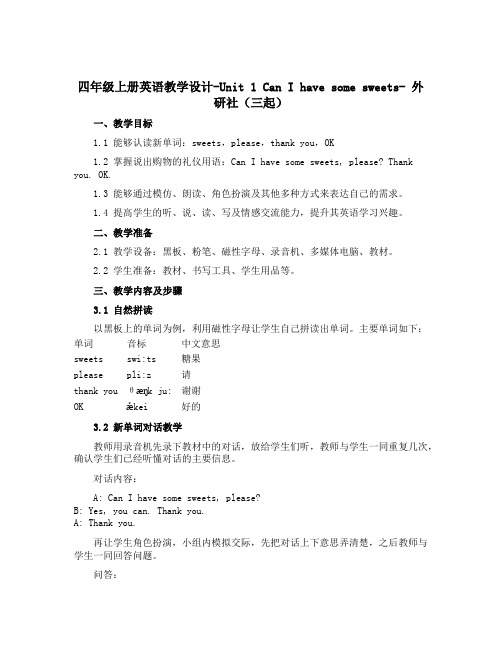
四年级上册英语教学设计-Unit 1 Can I have some sweets- 外研社(三起)一、教学目标1.1 能够认读新单词:sweets,please,thank you,OK1.2 掌握说出购物的礼仪用语:Can I have some sweets, please? Thank you. OK.1.3 能够通过模仿、朗读、角色扮演及其他多种方式来表达自己的需求。
1.4 提高学生的听、说、读、写及情感交流能力,提升其英语学习兴趣。
二、教学准备2.1 教学设备:黑板、粉笔、磁性字母、录音机、多媒体电脑、教材。
2.2 学生准备:教材、书写工具、学生用品等。
三、教学内容及步骤3.1 自然拼读以黑板上的单词为例,利用磁性字母让学生自己拼读出单词。
主要单词如下:单词音标中文意思sweets swi:ts糖果please pli:z请thank youθӕŋk ju:谢谢OKǽkei好的3.2 新单词对话教学教师用录音机先录下教材中的对话,放给学生们听,教师与学生一同重复几次,确认学生们已经听懂对话的主要信息。
对话内容:A: Can I have some sweets, please?B: Yes, you can. Thank you.A: Thank you.再让学生角色扮演,小组内模拟交际,先把对话上下意思弄清楚,之后教师与学生一同回答问题。
问答:•Who wants some sweets?•Can he/she have some sweets?•What does he/she say?•What does the other person say in response?•What should he/she say to express his/her thanks?•What does the other person say in response?3.3 板书演示在黑板上写出对话呈现,包括英语和中文,学生可以根据这些内容来模仿和学习。
牛津上海版九年级上 Unit One 全部教案
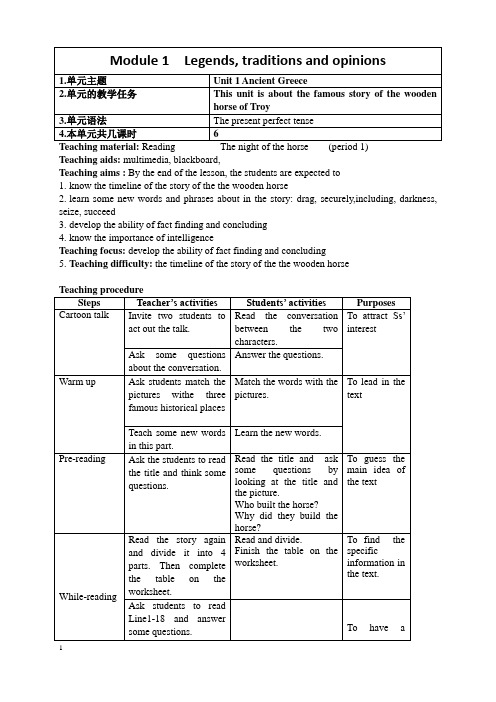
Teaching aids: multimedia, blackboard,Teaching aims : By the end of the lesson, the students are expected to1.know the timeline of the story of the the wooden horse2.learn some new words and phrases about in the story: drag, securely,including, darkness, seize, succeed3.develop the ability of fact finding and concluding4.know the importance of intelligenceTeaching focus: develop the ability of fact finding and concluding5.Teaching difficulty: the timeline of the story of the the wooden horseTeaching material: Reading The night of the horse (period 2)Teaching aids: multimedia, blackboard,Teaching aims : By the end of the lesson, the students are expected to1.understand what the pronouns refer to in the text and analyze the action of the characters in the text2.deduce the meaning from the text3.analyze the conversation between the characters and understand the ways of narration Teaching focus: deduce the meaning from the textTeaching difficulty:analyze the conversation between the characters and understand the ways of narrationTeaching material: Grammar The present perfect tense (Period 3)Teaching aids: multimedia, blackboardTeaching aims: By the end of the lesson, the students are expected to1) revise the structure and use of present perfect tense2) use the present perfect tense to talk about things that happened in the past but areconnected with the presentTeaching focus: the structure and use of present perfect tenseTeaching difficulty: using the present continuous tense to talk about things that happened in the past but are connected with the present板书设计The present perfect tensehave/has +V.PPadverbs and adverbial phrases: already just(affirmative)yet(negative/question), since,for, ever, never课后反思学生能够掌握现在完成时的结构和动词的过去分词的变化规则,对于特定的时间状语学生能准确掌握他们的用法,但如果把所有的时间状语放在练习中,非常容易搞错。
必修一unitone教学设计与反思模板
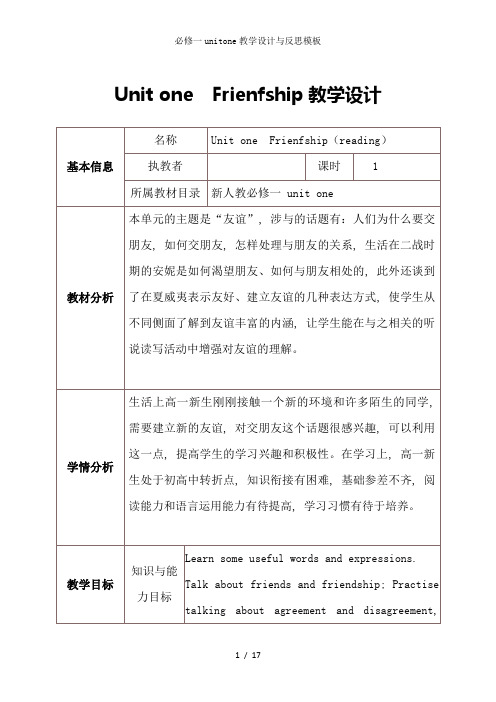
1).Imagine what it might be like if you had to stay in your bedroom for a whole year.You could not leave it even to go to the WC or to get a cup of tea.How would you feel
7.cheat. 1) v.to behave in a dishonest way in order to win an advantage;
2) n.a person who cheats; dishonest persons
They cheated the old woman of her house and money.
过程与方法目标
本单元在读前阶段就提出问题,让学生思考是不是只有人与人之间才能交朋友,然后在阅读中通过安妮的日记向学生说明我们也可以与动物与无生命的日记交朋友。在深刻理解、充分训练的基础上,可以再引导学生深入讨论几个与本单元话题有关的问题:1.描述朋友; 2.结交网友;3.观点交流;4.善\不善交朋友; 5.朋友的重要性。
Then began a series of wet days that spoiled our vacation.
This publishing firm is planning a new series of school textbooks.
They carried out a series of experiments to test the new drug.
高中英语必修三UnitOne教学设计

Unit 1 Festivals around the worldThe First PeriodTeaching Aims:1. Learn the following words and phrases:dress up, in memory of , arrival ,.2. Train the students ' speaking and listening abilities.3. Learn to talk about festivals, customs and habits.Teaching Important Point:Improve the students s'peaking and listening skills by talking aboutand listening to something about festivals.Teaching Difficult Point:How to further develop the students ' speaking and listening skills. Teaching Methods:1. Pair work and group work to train the students2. Listening and choosing activity to train the students li 'stening ability. Teaching Aids:1. Pictures2. a projector3. a tape recorderTeaching Procedures:Step I ・ GreetingsGreet the whole class as usual.Step H ・ Free Talk and Lead-in1. Ask the students to talk about the Spring Festival in China.2. Ask about some other festivals, such as: Lantern Festival, the Dragon Boat Festival, Harvest Festivals, Mid-Autumn Day, New Year ' s Day …3. Ask about some foreign festivals, such as: Christmas Day, Thanksgiving Day, Mother 'Dsay, April Fool 'Dsay, Valentine 'sspeakingaDay…Step皿・ Warming up1. Look at the pictures and discuss the three questions.(1) .Do you know the n ames of the festivals?⑵.Do you know which coun tries the festivals come from?⑶.What are the people in the pictures doing? Why are they doing this?2. Ask the students to think of a Chinese festival and a foreign festival, andthen work in pairs to compare them..Step W ・ Listening1. Do a listening and choosing exercise about the following three festivals:Mardi Gras, Ramadan and Easter.2. Ask the students to work together to describe one of theirfavourite festivals.Step V ・ Speaking1. Ask the students if they would like a new holiday, and ask them to decidewhat a new holiday should be about.2. After the students prepare for a while, teacher asks some students to talkabout their new holiday separately.Step 弋・ Summary and Homework1. Ask the students to remember the festival and learn to use them..2. Try to collect more information about festivals and prepare for next part.The Second PeriodTeaching Aims:1. Learn and master the following words: feast, ancestor, awards, gathered, look forward to2. Train the students ' reading ability.3. Let the students learn about the relation between festivals andhistory and culture.Teaching Important Points:1. Improve the students ' reading ability.2. Help the students learn about foreign history and culture by reading aboutfestivals.Teaching Difficult Point:How to help the students understand the passage exactly.Teaching Methods:1. Discussions before reading and after reading to make the studentsinterested in what they will read and further understand what they have read.2. Fast reading and careful reading to understand the passage correctly.3. Pair or group work to make the students take an active part in the activities inclass.Teaching Aids:1. a TV set and a VCD2. a projector3. a recorderTeaching Procedures:Step I ・ GreetingsGreet the students as usual.Step"・ Discussion and Lead-in1. Watch a program about a festival.2. Ask the students to talk about the program.3. Ask the students to discuss the questions below, four questions)4. Learn the new words in the passage.Step皿・ Reading1. Ask the students to read the passage silently and quickly to get the generalidea.2. Ask the students to answer some questionS. three questions)3. Re-read the passage carefully to further understand it. Then workin groups of four to discuss some questions.4. Read aloud the passage and try to understand it better.Step W ・ Listening and ConsolidationAsk the students to listen to the tape and finish the “true exercise on Page11.StepV ・ Summary and HomeworkPreview next part—Language study.The Third PeriodTeaching Aims :1. Review the new words appearing in the last two periods.2. Learn to use the modal verbs—must, have to, have got to.Teaching Important Points:1. Learn to guess the missing word according to the given sentence.2. Master the modal verbs correctly.Teaching Difficult Point:How to use “must”, “have to ”, “have got to ” properly and how their negative forms correctly.Teaching Methods:1. Practice and consolidate the words learned in the last two periods.2. Giving examples to explain the difference between “must”and“ haveto ”and the difference between “ mustn 'ant d”“ don 'hatveto ”.3. Making sentences to consolidate the usages of the modal verbs.Teaching Aids:1. a projector2. some slides3. some picturesTeaching Procedures:Step I ・ GreetingsGreet the whole class as usual.Step"・ Revision1. Ask the students to review something about Kwanzaa, such as the birthof it, the purpose of it, the way of celebrating it, and the seven principlesof it.2. Ask students some questions about the passage.3. Find the right explanation for each of the words, nation, faith, determinatio n, purpose, gen erati on, an cestor, peace trick4. Word Study. Ask the students to choose the best word to fill in eachblank.Step皿・ Grammar1. Modal Verbs: must, have to, have got to.2. The negative forms of the modal verbs.3. Do the exercises4.Step W ・ PracticeDo the exercisesStepV ・ Summary and Homework1. Review the contents in this class, paying attention to the differencesbetween “ must ” and “have to ” and the diffebetween “mustn't ” and “don't have to ”.2. Do more exercises to learn to use them properly.The Fourth PeriodTeaching Aims:1. Learn the following words and phrases:reminder, care about, respect, cycle, fool, play tricks on, take in, invitation2. Review the language points and modal verbs in this unit.3. Train the students ' integrating skills, especially writing skill.Teaching Important Points:1. Useful expressions: care about, play tricks on, take in2. Practice expressing and supporting an opinion.3. Write an invitation.Teaching Difficult Points:1. How to create a festival and describe it.2. How to write an invitation.Teaching Methods:1. Review method to consolidate the language points of this unit.2. Individual, pair or group work to finish the reading and writingtasks.Teaching Aids:1. a projector2. some slides3.Teaching Procedures:Step I ・ GreetingsGreet the whole class as usual.Step"・ Revision1. Review the usages of the modal verbs learned before.2. Read about some other festivals. Besides, ask the students to create afestival and then write an invitation to invite their guests to their festival. Step皿・ Reading1. Read some information about each festival .2. Ask the students some questions about the festivals in the passage.(four questions)3. Learn some useful expression in the passage. care about, play tricks on /play a trick on, take in)4. Give the students some more time to re-read the passageand discuss thequestions after the passage with their partners, and then check them out. Step W ・ Writing1. Ask the students to finish the contents mentioned on Page 8. Then write ashort description of their own festival. At the end, tell their classmates about their festival.StepV ・ Summary and Homework1・ Practice reading and writing about festival・2・ Learn more about festivals, customs and habits of foreign countries。
人教版unitone教案
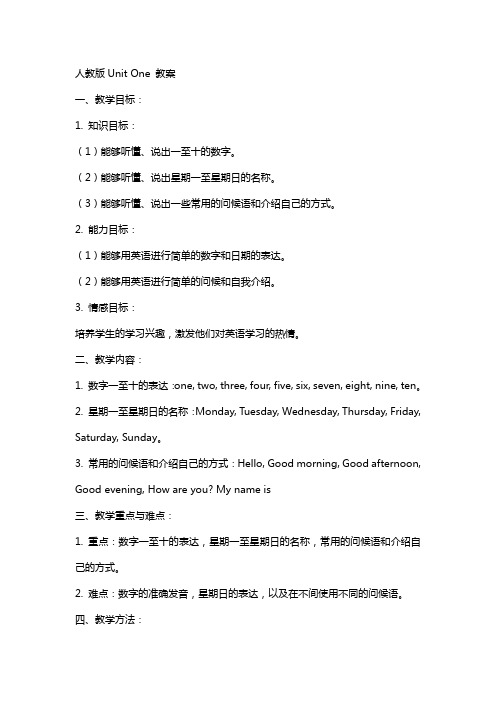
人教版Unit One 教案一、教学目标:1. 知识目标:(1)能够听懂、说出一至十的数字。
(2)能够听懂、说出星期一至星期日的名称。
(3)能够听懂、说出一些常用的问候语和介绍自己的方式。
2. 能力目标:(1)能够用英语进行简单的数字和日期的表达。
(2)能够用英语进行简单的问候和自我介绍。
3. 情感目标:培养学生的学习兴趣,激发他们对英语学习的热情。
二、教学内容:1. 数字一至十的表达:one, two, three, four, five, six, seven, eight, nine, ten。
2. 星期一至星期日的名称:Monday, Tuesday, Wednesday, Thursday, Friday, Saturday, Sunday。
3. 常用的问候语和介绍自己的方式:Hello, Good morning, Good afternoon, Good evening, How are you? My name is三、教学重点与难点:1. 重点:数字一至十的表达,星期一至星期日的名称,常用的问候语和介绍自己的方式。
2. 难点:数字的准确发音,星期日的表达,以及在不间使用不同的问候语。
四、教学方法:1. 情景教学法:通过设置真实的情景,让学生在实际语境中学习和使用英语。
2. 互动教学法:引导学生参与课堂互动,增强他们的学习积极性。
3. 游戏教学法:通过趣味性强的游戏,激发学生的学习兴趣。
五、教学步骤:1. 热身(5分钟):(1)教师与学生用中文进行简单的问候,介绍自己。
(2)学生模仿教师,用中文进行问候和介绍自己。
2. 引入(10分钟):(1)教师出示数字卡片,引导学生说出数字一至十。
(2)教师出示星期卡片,引导学生说出星期一至星期日的名称。
3. 新课教授(15分钟):(1)教师创设情景,让学生练习使用数字和星期进行问候。
(2)教师引导学生进行角色扮演,练习自我介绍。
4. 课堂练习(10分钟):(1)教师组织学生进行小组活动,用英语进行数字和星期的问答。
人教版unitone教案
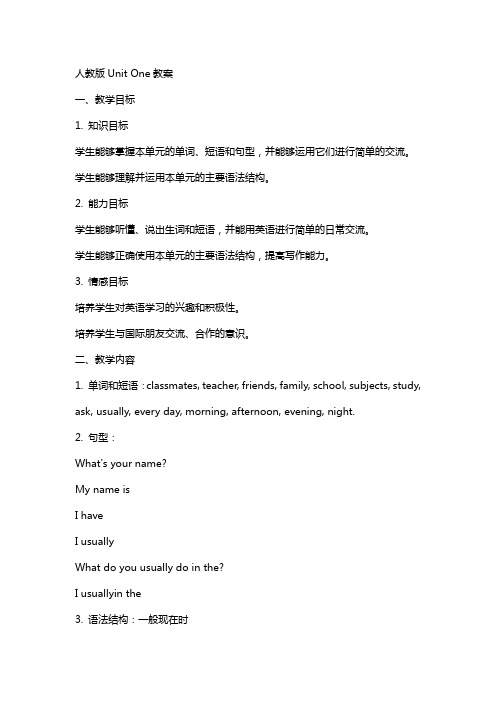
人教版Unit One教案一、教学目标1. 知识目标学生能够掌握本单元的单词、短语和句型,并能够运用它们进行简单的交流。
学生能够理解并运用本单元的主要语法结构。
2. 能力目标学生能够听懂、说出生词和短语,并能用英语进行简单的日常交流。
学生能够正确使用本单元的主要语法结构,提高写作能力。
3. 情感目标培养学生对英语学习的兴趣和积极性。
培养学生与国际朋友交流、合作的意识。
二、教学内容1. 单词和短语:classmates, teacher, friends, family, school, subjects, study, ask, usually, every day, morning, afternoon, evening, night.2. 句型:What's your name?My name isI haveI usuallyWhat do you usually do in the?I usuallyin the3. 语法结构:一般现在时三、教学步骤1. 热身(5分钟)教师与学生进行简单的英语对话,检查学生对之前学过的知识的掌握情况。
2. 引入(10分钟)教师通过展示图片或视频,引导学生谈论学校生活,引出本课的主题。
3. 新课呈现(15分钟)教师通过示例和讲解,教授本课的单词、短语和句型。
4. 练习(15分钟)学生进行小组活动,用所学的单词、短语和句型进行交流,巩固所学知识。
5. 课堂作业(10分钟)学生完成课堂作业,教师进行个别辅导。
四、课后作业1. 学生回家后,复习本节课所学的单词、短语和句型。
2. 学生完成课后作业,巩固所学知识。
五、教学评价1. 课堂参与度:观察学生在课堂上的发言和互动情况,评价学生的参与度。
2. 课后作业:检查学生的课后作业,评价学生对所学知识的掌握情况。
3. 口语表达:在课后与学生进行口语交流,评价学生的口语表达能力。
六、教学策略1. 任务型教学法:通过小组活动和互动交流,激发学生的学习兴趣,提高学生的参与度。
一年级英语教案unitone

一年级英语教案U n i t O n eH e l l o(总6页)-CAL-FENGHAI.-(YICAI)-Company One1-CAL-本页仅作为文档封面,使用请直接删除Unit One HelloThe first periodⅠ Teaching objects : Introduction: Hi / Hello, I’m Ken / Ann / Mockey / Uncle Booky..Greetings: Hi / Hello, Ken / Ann / Mocky / UncleBookyⅡ Teaching key points : Greetings and introductions.Ⅲ Teaching difficult points :Hi / Hello, I’m ….Hi / Hello , ….Ⅳ Teaching procedure⒈Warm-upHave the children say their names and have the whole class must be able to say the name of each child.⒉ PreviewShow children the poster for this unit.⑴Point to Mocky and ask , “Who’s this ” Elicit, “Mocky.”Have the children repeat “Mocky”.⑵Point to Ken and say , “This is Ken . Hi, Ken.” Model thename Ken at least twice, then have the children repeat afteryou.⑶Point to Ann and repeat the step above to model the name Ann .⑷Review the names of the key characters by pointing to each oneand asking , “Who’s this ” Elicit, “Mocky, Ken, Ann.”⒊Presentation of new language⑴Have the children watch you leave the room for a few seconds .Come back in waving and introduce yourself, “ Hello,I’m ….”⑵Hold up the puppet of Mocky and indicate that he is greeting andintroducing himself to the class . Say, “Hi, I’m Mocky .”Have the children listen and repeat.⒋Story⑴Have children look at the picture . Ask, “Who can you see” Elicit, “Mocky, Ken, Ann.”⑵Ask children to look at and describe the picture .⑶Play the tape . Have the children look at the picture as the tape is played.⑷Encourage the children to say the words.⒌ Learn to say⑴Direct the children’s attention to the characters’names.⑵Replay the tape.⑶Point to the picture and ask “What do you think she is saying”Elicit, “Hello, Ken.” And then repeat the step above for“Ann” and “Mocky”. Varying the greeting between “Hi” and“Hello”.⑷Introduce “Uncle Booky”.⑸Practice the sentences.⒍ Extension⑴Ask the children to take out the mask outlines and materials formaking masks.⑵Show the children how to color their masks, cut them out andglue them onto the craft stick handles.Ⅴ Homewor k⒈ Listen to the tape.⒉ Read P1 & P2.Ⅵ Blackboard writingUnit one Hellothe poster of Ken the poster of Annthe poster of Mocky the poster of Uncle BookyUnit One HelloThe second periodⅠ Teaching objects⒈Have students do the actions according to teacher’s instruction.⒉ Sing a song.Ⅱ Teaching key pointSing a song.Ⅲ Teaching difficult pointTo und erstand the words “ nose, eyes, ears , mouth” and the sentence “Touch your….”Ⅳ Teaching procedure⒈ Warm-up⑴Play the game “pass the ball” to review the sentence pattern “I’m….”⑵Continue the game until all the children have chance to say their names at least once.⒉ Preview⑴Hold up the puppet of “Mocky” and indicate that he is speakingto the children. Say, “Hello, I’m Mocky.” Have children greet him and say, “Hello, Mocky.”⑵Repeat the step above with the masks of “Ann”, “Ken” and“Uncle Booky”. Have children practice greeting them using“Hello” and “Hi."⒊ Listen and act⑴Hold up the puppet of “Uncle Booky”. Have children greet him.⑵Point to Uncle Booky’s nose and say, “Nose.” Model at leasttwice.⑶Children repeat after the teache r. Repeat the step with “eyes”,“mouth” and “ears”.⑷Hold up the puppet of “Uncle Booky” and “Mocky”. Explain thatUncle Booky is speaking to Mocky. Play the tape, “Touch yournose, please.” Pretend to be Mocky and do it as required. Model at least twice.⑸Play the tape and ask children to listen and point to the rightpicture on their books. Then ask children to follow your models.At last, give out instructions and let children do it.⑹Repeat the above steps with the following instructions: Touchyour eyes / mouth / ears , please.⒋ Sing a song⑴Explain to children that they are going to learn a song aboutpeople meeting each other for the first time.⑵Have children open their books and look at the illustrations thataccompany the song.⑶Read the words to the children, pointing to each word. Play thetape for the whole song and have children listen and point toeach character as the sing.⑷Play the tape again and have children join in, encouraging themto clap, hum, and move around. Divide the class into four groups.Have each group sing the part for their character, then havegroups change masks. Ask for pair to volunteer to sing a verseusing their own names.⒌ ExtensionPlay remembering names.Ⅴ Homework⒈ Listen to the tape.⒉ Sing the song for friends or parents.Ⅵ Blackboard writingUnit One HelloHello, hello,I’m Mocky,I’m Mocky.Hi, I’m K en.Hello, hello,I’m Ann,I’m Ann.Hi, I’m Uncle Booky.Unit One HelloThe third periodⅠ Teaching objectGrasp four new words: an apple, an ant, a book, a banana.Ⅱ Teaching key pointGrasp four new words: an apple, an ant, a book, a banana.Ⅲ Teaching difficult pointSay the rhymeⅣ Teaching procedure⒈ Warm up⑴Take the puppet of Mocky outside the classroom with you. Have thepup pet peep around the door and say, “Hello, I’m Mocky.”Encourage children to return the greeting and elicit, “Hello / Hi, Mocky.”⑵Ask some children to take turns to leave the classroom, come backin and greet the class by saying, “Hello / Hi, I’m ....”T hey can also shake hands.⒉ Listen and practice⑴Have children open their books and draw their attention to thephotograph of the apple. Elicit “apple”.⑵Play the tape, Pointing to the photograph matching the word.Replay the tape and have children touch the photograph as they listen. Play the tape one more time and have children listen and repeat the word “apple”.⑶Repeat the procedure with the words “ant”, “book”,“banana”.⒊ Say the rhyme⑴Read the rhyme to the children, pointing to each word.⑵Explain the main idea of the rhyme to the students.⑶Play the tape for the whole rhyme and have children listen andpoint to the “apple” and “banana” when they are mentioned.⑷Play the tape again and have children join in, encouraging themto clap to keep the rhyme .⑸Change “apple” and “banana” for “ant” and “book” when thechildren can say the rhyme fluently .⑹Let children imitate the rhyme and learn it as a whole.⑺Add some actions when chanting the rhyme and ask children to actout.⒋ Look and match⑴Hold up the word cards ( apple, book, ant, banana ),ask childrento say these words in English.⑵Have children open their books and look at the picture. Encouragethem to describe what they see.⑶Direct children’s attention to the English word s and read outaloud the words.⒌ ExtensionPlay Masks.Ⅴ Homework⒈ listen to the tape.⒉ Say the rhyme to friends or parents.Ⅵ Blackboard writingUnit One Helloan apple a bananaan ant a bookUnit One HelloThe fourth periodⅠ Teaching objects⒈Review the structure: Hi / Hello, I’m….⒉ Vocabulary : apple, ant, book, banana, Ted, Lisa, Tina, TimⅡ Teaching key pointHello / Hi, I’m…Ⅲ Teaching difficult pointTed, Lisa, Tina, TimⅣ Teaching procedure⒈ Warm up⑴Begin the class with students saying the rhyme loudly,encouraging them to clap to keep the rhythm.⑵Play a game. Use the structure “Hello, I’m…” Play a tape ofsome lively music. Explain that when the music is playing, they must keep moving, but when the music stops they must “freeze”and shake hand and introduce themselves.⑶Start the music and have children practice the dialog with apartner. Pause the music and have children “freeze”, thenstart the music again and have them change partners. Continueuntil each child has greeted and introduced him / herself to at least five other children.⒉ Review with posterReview the vocabulary and structures for this unit with the poster.⒊ Listen and say⑴Have children open their books and look at the pictures. Pointto each drawing and ask, “Who’s this” Say the name and have children repeat “Tina, Ben, Lisa, Ted, Tim.”⑵Direct children’s attention to t he sentence to be read.Explain that they are going to listen to the tape and thenrepeat what each character is saying.⑶Have the children read the words and each sentence. Point toeach drawing and elicit the completed sentence in a choraldrill.⑷Point to the final space and explain that the children aregoing to draw pictures of themselves. Have them draw theirpicture and trace the words, “ Hi, I’m...”⑸Have them write their names in the space provided to completethe sentence.⑹Check the exercise by having children share their drawings.⒋ Find and color⑴Have children read the words.⑵Ask children describe the picture.⑶Give children some time to look for the objects and color them.⒌ ExtensionPlay “run to the corner”.Ⅴ Homework⒈ Listen to the tape.⒉ Read P2 – P8.Ⅵ Blackboard writingUnit one HelloHello, I’m Ben.Hi, I’m Tim.Hello, I’m Lisa.Hi, I’m Tina.Hello, I’m Ted.。
- 1、下载文档前请自行甄别文档内容的完整性,平台不提供额外的编辑、内容补充、找答案等附加服务。
- 2、"仅部分预览"的文档,不可在线预览部分如存在完整性等问题,可反馈申请退款(可完整预览的文档不适用该条件!)。
- 3、如文档侵犯您的权益,请联系客服反馈,我们会尽快为您处理(人工客服工作时间:9:00-18:30)。
本环节主要是通过对“there be”及“be + adj”用法的学习,更好地对人和地点进行准确描述,最终达到单元目标。整合内容:Language in useand Skill practice
二、分课时教学设计
第2课时
教学目标
知识目标
1掌握描述人和地点的词汇: friendly, polite, warm, nice, noisy, modern, clean等
满足不同层次学生的需求
板书设计
Unit 1 Nice People, Nice Places
place: PeopleStructures:
NoisyfriendlyBe back from…
cleanpoliteHow do you find…
modernnice There is / are…
tallwarm It must be…
5分钟
确定项目任务
1.图片秀导入
(关于世界各地名胜古迹,素材由学生课前搜集)
2.问题
Can you introduce the places to a foreigner?
3.提出项目任务
To be a tour guide for foreigners
(要求:用英语简单介绍人文地理 并与游客谈论旅行经历)
情感目标
1.通过丰富的课堂练习和小组活动,增强团队意识和竞争意识
2.通过对世界各地人文地理的了解,激发学习英语热情,并树立职业理想
教学重点
掌握描述人和地点的形容词
掌握谈论旅行经历的句型
教学难点
能正确运用谈论旅行经历的句型
教学方法
项目教学法
学习方法
小组学习法
教学过程
预设时间
教学环节
教师活动
学生活动
设计意图
3 基础知识:
基础较差,缺乏信心
4 认知特点:
喜欢生动、活泼、有趣的事物;思维活跃,接受能力强
5 学习需求
希望能提高职场英语能力,能与他人进行有效交流。
对策:结合专业特点,利用多元化教学手段和丰富的教学资源进行生动教学。
课时划分
第一课时:warming up
本环节主要是向同学们展示大家熟悉的世界各地的图片和视频,以此激发学生的学习兴趣,引出本单元话题,同时学习常见国家名称和国籍。整合内容:Around the world
It must be…
people there are…
There is…
汇总提炼
Choose thecorrect words and sentences todescribe the picture
3成果展示
每组派两名同学进行成果展示
1扫除词汇障碍
2锻炼听力技巧
增强合作意识
培养自主探究能力
提高职业素养
C:汇总、提炼、展示
3.合理分工(3、3、2)
1培养学生团队意识
2培养学生自主探究能力
3培养学生沟通能力
28分钟
实施项目过程
1课文呈现
Pre-listening
词语配伍,猜字游戏
while-listening
放录音三遍
post-listening
巡查、指导
2小组合作
巡查、指导
Байду номын сангаас3成果展示
提醒学生注意仪容仪表及语音语调
7分钟
项目评估
老师点评
1指出优点和不足
2根据评价表内容选出优秀员工和小组
学生自评
指出优点和不足
1培养发现问题解决问题的能力
2培养竞争意识
1
作业
1基础作业
A.熟读单词和对话,完成课后练习
B.预习Reading and Writing
2拓展作业
1.搜集家乡素材,运用本课知识进行描述,下节课做值日报告
2.与朋友谈论你的旅行经历
3本单元话题与学生专业息息相关,通过本单元的学习,学生能够用英语简单描述人、地点以及谈论旅行经历,从而有助于学生提高职场英语的运用能力。
学生情况
分析
2014级高一新生,情况如下:
1 年龄特点:
女生占绝大多数,年龄段:15-17岁。
2 专业特点:
旅游专业,要求学生有过硬的英语听说能力,同时要具备较强的人际交往能力以及服务意识。
1课文呈现
熟悉新单词意思
一遍:掌握大意
二遍:抓有效信息
三遍:熟悉对话
整合收集到的资源
2小组合作
收集词汇
People: nice friendly warm polite kind…
Place: noisy busy modern beautiful…
归纳句型
be back from…
how do you find…
crowdedkind People there are…
beautiful
large
教学反思
亮点
1.多媒体和网络资源的使用,提高了学习兴趣和效率
2.结合专业特点,创设情境,实践运用
不足
受时间限制,对基础差的学生指导不够
第二课时:Listening and Speaking
本环节主要是通过小组合作的方式,从听力材料中获取有效信息并进行归纳总结,最终达到谈论人,地方和旅行经历的目标。
第三课时:Readingand Writing
本环节主要是通过阅读文章与完成练习,在培养学生阅读技巧的同时帮助学生了解一些重要国家的信息,渗透人与人之间的友好关系以及人与自然之间的和谐相处。整合内容:For better performance
以及掌握重要国家和国籍的词汇:China, Chinese, America, American, Britain, British等
2掌握谈论旅行经历的句型:How do you find…There is/are…be + adj…等
能力目标
1.能够谈论人、地方和旅行经历
2.能够准确地从谈话中获取有效信息
1观看图片秀
2.讨论并回答问题
3.明确项目任务
To be a tour guide for foreigners
1激发兴趣
2导出项目
3明确项目
5分钟
制定项目计划
1.播放图片秀
(世界各地名胜古迹)
2.巡查、指导
3.巡查、指导
1.选择图片
(描述对象)
2.制定项目步骤
A:收集描述人和地的词汇
B:归纳总结句型
教学设计
一、单元整体解读及分析
Unit1Nice People, Nice Places
单元内容
分析
1本单元在简单介绍世界上一些国家及自然状况的基础上,强调了人与人之间的友好关系,人与自然之间的和谐,增强了学生文化素养与跨文化意识。
2本单元内容丰富,生动有趣,既提高了学生的文化素养,也激发了对英语学习的热情,本单元作为本书第一单元,为学生后面的学习起到了铺垫作用。
